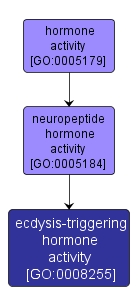GO TERM SUMMARY
|
| Name: |
ecdysis-triggering hormone activity |
| Acc: |
GO:0008255 |
| Aspect: |
Molecular Function |
| Desc: |
The action characteristic of ecdysis-triggering hormone, a peptide hormone that, upon receptor binding, initiates pre-ecdysis and ecdysis (i.e. cuticle shedding) through direct action on the central nervous system. |
|

|
INTERACTIVE GO GRAPH
|














